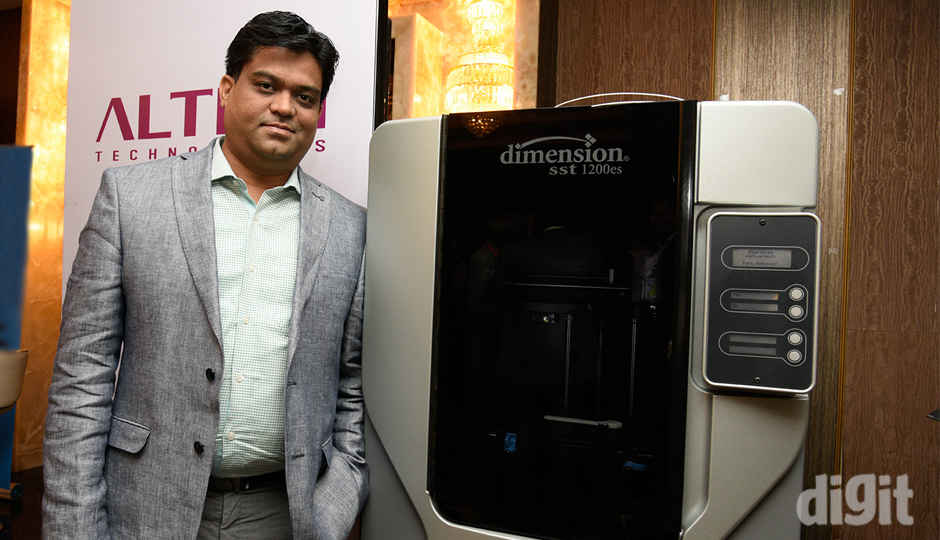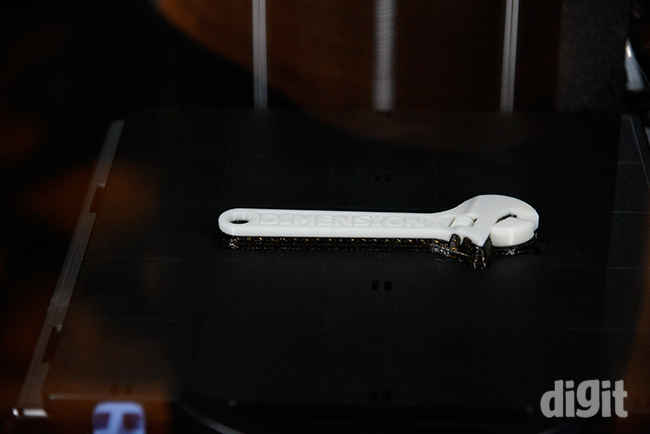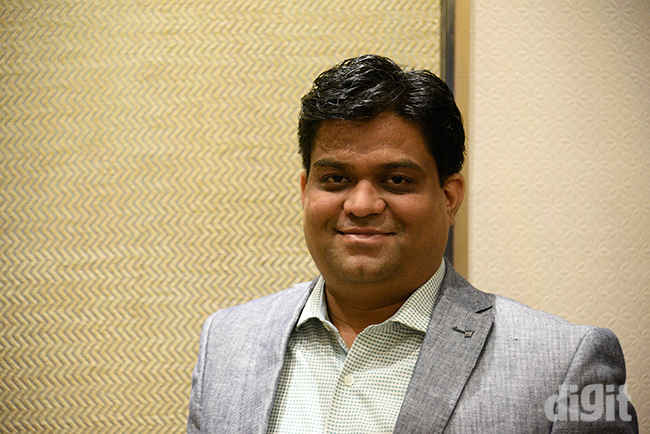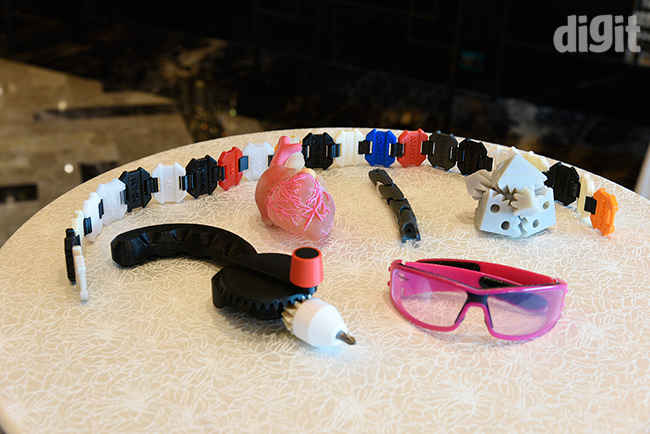Srinivas Shastri on the current state of 3D printing

We chat with Srinivas Shastri of Altem Technologies about the recent trends in 3D printing, shedding some light on the different materials used in the process and what the future holds in medical applications.
Digit: Tell us more about Altem Technologies.
Srinivas: We are a company which is into the complete spectrum of 3D CAD modelling and 3D printing so, we offer Internet solutions when it comes to CAD, backward and forward integration of the products. So, we have softwares for 3D CAD or 3D modelling, we have tie ups with Dassault Systems, the factory products we get here and other products of Dassault Systems and further, we have collaborations with MSS softwares for all the analysis and CA solutions, 3D printing with Stratasys for all plastic 3D printing or prototyping and we have tie ups with SLM Solutions, Germany, for metal 3D printing. And to complete the cycle we have a tie up with Arctec which is mainly into 3D scanning. So, this is the product offering we have at Altem.
Digit: Can you briefly explain the entire process right from the ideation to the final product?
Srinivas: So, see what happens as a designer is as soon as he designs something he wants to try out, whatever the new design he has done, it can be a part or an assembly. What happens nowadays is they wait for the final design to happen and then send it to a third party bureau or directly get it into tooling, because they are validated by software but you don’t get the touch and feel of the part and then there are a lot of acumens that you miss without going for a physical prototype which can only be addressed by a 3D printed part or a regular prototype. It can either be a subtractive or additive one. So, the value proposition of 3D printing here is that the designer gets to feel the part as soon as he does the changes or wants to prove that the design he has done is correct and there are no flaws taking it further. So, if you haven’t validated your design and straight away take it to some other assembly, it will have a cascading effect on the entire product. So, it may not work the way you want. So, 3D printing exactly fits in there wherein it gives you lots of freedom to ideate and iterate. If you have some idea, you immediately design and get the part out with a 3D printer, and then if you aren’t happy or satisfied with it, you can iterate it. There is no penalty for your incorrect or inferior design. If you straight away get into tooling, then you are paying a fortune correcting your mistakes. So, 3D printing allows you to do that without any penalty, which is the best part about it. It’s not just 3D printing, it’s gone beyond that. It’s not just visualisation or concept proving that you are doing with 3D printing, it’s going beyond prototype. You can actually do functional testing with it, you can do manufacture tooling with it or in some cases if you have limited quantities, you can induct pouring batches of actual production parts without even going for tooling. So how does that sound? That is what 3D printing does.
Digit: How are 3D models created?
Srinivas: You don’t need tooling in 3D printing, that’s the best part and not like subtractive prototyping actually, wherein you need to have separate fixtures, and the entire process planning has to be done. Here, every design is the same, irrespective of the vertical revolving. It can be a medical part or it can be an aerospace part; for the 3D printer, the process is the same, so whatever design is there in the CAD software, you don’t need to be an expert in using that. It just takes a couple of hours for someone to get their hands on 3D printing and get repeated. So, that way every design is the same, we are not really worried about the process planning and you don’t need to be a manufacturing engineer to know that. I will say that as long as you can read and speak english, you can 3D print.
Digit: How easy is it for anyone to design a product who doesn’t have any prior experience. Say, if I have a startup coming up and it is a hardware startup or something which involves a working model. Will I be able to have a 3D printed prototype?
Srinivas: Yes, if your requirement is a part, or if you have to design it then it is a different story, you definitely need to have a CAD software. Say, if you have to fix something and then you need that part replaced, that’s where 3D scanners come in, you don’t need to be a design engineer to reverse engineer it. You take a part and then you just 3D scan it. Then the 3D scanner 3D prints it. You are completely eliminating the designer out of the picture. We already have some designs that can’t be copied but reversed engineered and then you get it printed out of the 3D printer. It’s so simple that you don’t need to be a design engineer or mechanical engineer to do that, but yes it would help if you are one. Otherwise, it’s not a prerequisite to operate one.
Digit: In 3D printing, what are the different types of materials used to build products and prototypes?
Srinivas: When it comes to 3D printing, the major material application is driven by plastics and to some extent metals which is currently gaining momentum in the market. Looking at plastics in Altem, we have tie ups with Stratasys wherein we offer real engineering thermoplastics like AVS, polycarbonates, polyvinyl celofoams and nylon. These are the real life materials that are used in everyday life, you can look at your TV, remote, AC. They all fall in one spectrum of materials that I mentioned. Yes, as of now the materials are driven by OEM supplied ones, that’s what you can use on the printer. So, it’s either the materials or the plastics or you have the flexibility when it comes to metals to using your powder because it requires a different technology matrix of powder metallurgy. So, to use the metal of your choice, you can get the powder of your choice. As of now, it is mainly driven by the OEM supplied materials.
Digit: We have seen that 3D printed materials don’t have a very good finish or aren’t very polished. How is that improving?
Srinivas: 3D printing has evolved a lot in the last decade. Yes, I completely agree with you, when initially the parts were printed maybe 10-12 years ago, the finish was not so great or it was just one material that was used, the consumer didn’t have much of a choice. Some of them were really concerned about that aspect but lately, with the new materials and technologies getting better. It all depends on what technology you use and for what application. Some application may not need a completely smooth part, they may be required for some functional mechanical application on a shop floor or on a vehicle which doesn’t really need this kind of finish. But now the printers and technologies have really evolved and we have parts which are really smooth. It’s not just one material, but multiple materials. If you need a transparent material, if you need a flexible material, you need materials with colours, everything is available. Definitely, technology has evolved a lot in the last 10 years. We have a new technology called Connex running which can almost get a combination of 1800 materials using basic 14 materials.
Srinivas Shastri, Technical Director, Altem Technologies
Digit: The material you are holding now has several moving parts (check video for reference). What material has been used? Has it come out in a single print?
Srinivas: This is an acrylic based resin which is photo curable, so basically this resin is jetted out and exposed to UV light into a hardened state. The moving parts are all done in a single print. 3D printers are capable of printing the part with a complete moving assembly. How it works is 3D printers come with an option of having a support material, which basically supports any void present in the structure. So, basically if you look at this assembly (check video for reference) the clearance is a void which is filled with a temporary material called a support material. The 3D printer’s software decides where the voids are then the software fills it up with the temporary material and eventually when the part is built, it is dropped into water or washed away with a jet and then you can have completely built assemblies like this one.
Digit: So, you’re saying moving parts aren’t restricted to the material used?
Srinivas: No, there is no restriction on the moving parts, you just need to take care of the minimum clearances you need to provide and then you have assemblies like this printed out from a printer in a single print.
Digit: What is the limit on the size of the materials that can be printed?
Srinivas: The size of the parts that can be printed is basically dependent on the size of the printer you have. We have printers starting from 6 cu inches or 150mm up to about 1000mm or 1m part. Size is not a limitation because you can always section the parts and assemble them. As a single part, it will be driven by the volume of the build that is available in the given printer that you have.
Digit: As we observe that currently 3D printers have applications only in industrial applications, do you see it coming to households sooner since there are affordable 3D printers already coming into the market?
Srinivas: Yes, I would think that will be the holy grail of the future, the only thing that is restricting is basically the content. Let’s think of something simple like replacing a knob which is broken in your house. Where is the content for that? Now most of the 3D printing companies are working on that ecosystem wherein they have tied up with a lot of software or CAD companies which have all the 3D content or the 3D part library on the cloud. You log on to the cloud, download the part you want and then start printing. You have to do that in a bigger way because not everything has 3D dat. If you look at any of your household gadgets they don’t give you the 3D library for that but someday the manufacturer will be forced to give that which will be stored on the cloud and you can download it. If you have the data then you wouldn’t need anyone to supply you parts which have broken down. You can access them from your house through your desktop.
Digit: Other than industrial products, where do you see 3D printers going. What kind of other fields can 3D printers be used?
Srinivas: Yeah all these years it was mainly in the engineering domain where 3D printers were being used, but in the last couple of years there has been a lot of attraction in medical and dental applications. There are a lot of 3D printed organs that are directly printed not intended for replacing real organs but these are basically presurgical models. So, if someone has to be operated upon is basically scanned and that scanned data is converted into 3D data and then printed for them to analyse problem in that particular area which they are going to operate.
It’s sort of a pre-surgical study model being printed, for example, we have here the heart (check video for reference). The doctors can use the same model which is the actual patient’s model and then they will be able to capture a lot of missing data which they are definitely going to miss using MRI or CT because it’s always a 2D view. So, using an actual 3D printed part, planning the surgery can get better which means the actual time in the operation theatre on discovering the problem and improvising is reduced. They can be better planned with all the fixtures and tools that are required to fix the issue to not having major hassles when they cut open the patient. One more reason is that it helps the patient’s recovery faster because whenever they are in the OT, there are a lot of organs or blood which is by passed to operate on that particular area. If you keep the organs deprived of blood there are chances that the recovery will be slower or it may damage it further. So, if you plan your surgeries better then you have a better recovery rate and the surgeons can be better equipped to perform them. That’s in the medical field. Customised implants can be provided using 3D printing.
One more application which is going forward is dental industry. Everybody is moving into digital dentistry eliminating the manual methods. So, it can be implants or the ridges that are there which is basically metal 3D printed or using your prosthodontics and orthodontics all the corrections can be modelled with a 3D printer and the entire workflow is digitised. That’s where we see a major growth, infact Stratasys has a range of dental portfolio printers just addressing the dental market. Not only patients will have their own portfolios, even when you are correcting your teeth, in kids you have seen the braces, so now it’s moving away from those steel braces to clear aligners. You won’t even notice there is a brace and then you will have a correction program based on that. So, that is seeded by 3D printing and no other process can help you in doing that. That’s where the future lies basically I think other than engineering applications, automotive and aerospace which is already proven. The upcoming ones that will be the life changing is the medical application.
Digit: In a few years will we have 3D printed organ transplants?
Srinivas: That’s the future everybody is thinking of but then I think we are far away from that because we would need materials which are very biocompatible, which don’t really damage your other organs. As of now I don’t think we are there but maybe in the future we will.
Digit: Since you have been in the 3D printing industry for a long time, what are the improvements that it needs currently?
Srinivas: The major improvement that I would aspire in 3D printing is the material of your choice and the speeds wherein 3D printing can completely replace CNCs. This is more eco-friendly and there is less wastage, everything can be localised, so that way speed and choice of materials are the limitations which can replace the CNCs. It can lead to actual manufacturing centers replacing the conventional CNC manufacturing.
Abhijit Dey
A Star Wars fan and sci-fi enthusiast. When I'm not playing games on my PC, I usually lurk around the Internet, mostly on Reddit. View Full Profile








